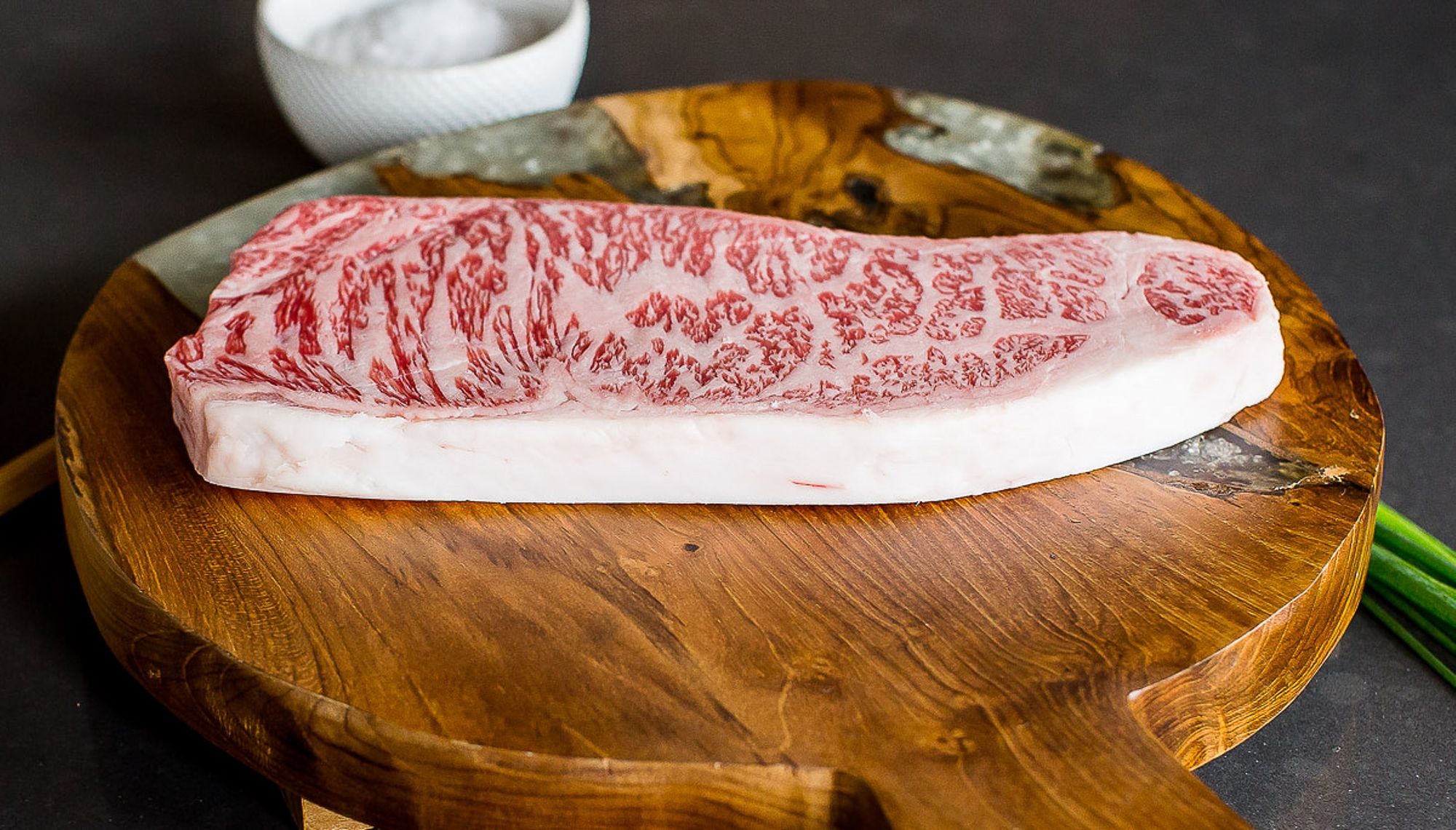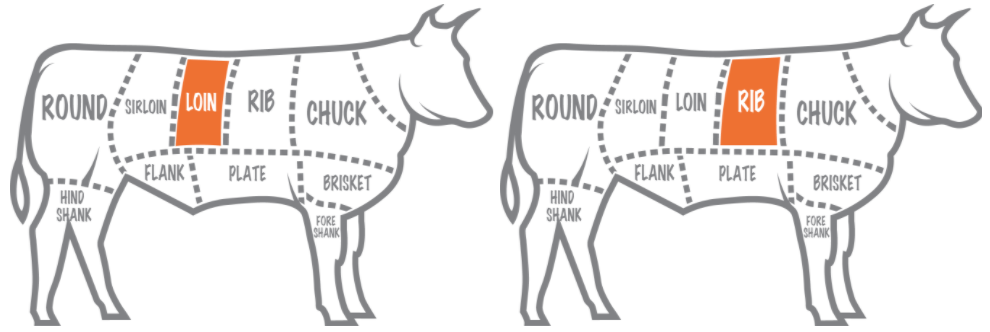Japanese Wagyu is one of the most luxurious foods in the world — a distinction earned not just because of its unique Kuroge genetics, but because of the many traditions practiced in Japan, spanning from the way the animals are raised to how the meat is rated, how the steaks are sliced and cooked, and even how the carcasses are butchered.
There are a few key differences in Japanese Wagyu butchery versus that in the United States: carcass breaking (the actually butchery), grading, and steak thickness.
BUTCHERY
Certain Japanese Wagyu cuts are broken (processed) differently that US Beef.
Japanese Wagyu Striploin Steaks (New York Strips), for example, are 5-bone, containing ribs 6 through 10, while US beef ribloins (ribeyes) are 7-bone, containing ribs 5 through 12.
The striploin and ribeye are from different areas (the loin and rib, respectively), but are both part of the longissimus dorsi, a muscle that run down the side of the spine on the outside of the ribs. Japanese striploins may appear different because they are cut further into the beef and contain the visually distinct spinalis muscle, which is typically seen in a US domestic ribeye.


GRADING
The US and Japanese beef grading systems are also vastly different.
US Beef are graded on two dimensions: quality grades for tenderness, juiciness and flavor; and yield grades for the amount of usable lean meat on the carcass. Beef quality grading is primarily based upon the degree of marbling, as well as the degree of maturity.
Marbling (intramuscular fat) is the dispersion of fat within the meat. In the US, marbling is graded by the amount and distribution in the ribeye muscle at the cut surface after the carcass has been ribbed between the 12th and 13th ribs.
Japanese carcasses are cut or ribbed between the sixth and seventh rib throughout Japan. The Japanese beef grading system has much more detail and is evaluated based on yield grade and quality grades. There’s also separate scale for the marbling itself called Beef Marbling Standard (BMS). BMS standard goes from 1 (lowest) to 12 (highest).
There are three yield grades: A, B and C — classified by yield percentages estimated by an equation.
Yield score is determined by an estimated cutability percentage that is calculated by an equation which includes four carcass measurements. The measurements are obtained at the sixth and seventh rib section. The yield grading is absolutely objective, delivering an estimated yield percentage as follows
Grade A - 72% and above
Grade B - 69% and above
Grade C - under 69%
There are five meat quality grades: 1, 2, 3, 4 and 5 — based on marbling; meat color and brightness; firmness and texture of meat; and color, luster and quality of fat. The relationship between beef marbling evaluation and classification of grade is as follows:
1) Poor — 1
2) Below Average — 2
3) Average — 3-4
4) Good — 5-7
5) Excellent — 8-12
With this in mind, an A5 cut, for example, would come from a carcass with a yield grade of 72% and above (A), with an excellent quality grade, on the marbling scale between 8-12 (5).
THICKNESS
The last main difference is simply the thickness of the cuts.
Traditional American steaks, such as a Ribeye or New York Strip, are typically cut to about 1” or more in thickness depending on the cut (which is how most of our grain-finished steaks are processed). However, in Japan, traditional Wagyu steaks are cut thinner to provide the best eating experience — accounting for the richness as well as the higher price-point, and encouraging smaller portion sizes.
Thinner steaks also celebrate the traditional Japanese cooking style for Wagyu. The popular Japanese style is teppanyaki, where thin strips are seared on a stainless steel pan/skillet. Cooking in a hot skillet (not grilling) is the preferred cooking method for Wagyu. Steaks should be seared quickly on each side, warming the meat just enough to melt the interior fat. A5 Wagyu is meant to be shared and enjoyed as an experience — not a full meal.
The A5 Wagyu we import from Japan follows the exact specifications of Japan's top steakhouses:
- Ribeye — Cut 3/4" thick, weighing 15-20 oz. (estimated range) depending on what section of the primal it came from.
- Striploin Steak — Cut 3/4" thick, also weighing 15 to 20 oz (estimated range,) depending on what section of the primal it came from.
- Tenderloin Steak — Cut to a target weight of 8 oz, and thus ranging in thickness from 1½" to 2" thick
- Rib Cap Steak —Cut to 6 to 7 oz, and generally 1 to 1½" thick, depending on what end of the primal it comes from.
- Rib Cap Strips — When not enough of the rib cap is left to make a steak, and it begins to taper off, the remainder is cut into strips about 1" thick

FAQs
Q: Does Japanese Wagyu Striploin eat differently than a typical Angus NY Strip Steak, due to containing the spinalis muscle?
The spinalis muscle doesn’t affect the overall chew and taste of the Japanese Wagyu striploin, but the steak itself will be much more tender and rich than a typical Angus NY Strip due due to the extreme marbling and high oleic fat content.
Q: How should I cook my Japanese Wagyu Striploin? How can I avoid overcooking my Japanese Wagyu Striploin?
For detailed instructions and videos about how to cook Japanese Wagyu Striploin, check out these tips and tricks.
Q: I’d love to share my Japanese Wagyu Striploin! How many servings does a 12 oz Japanese Wagyu Striploin contain?
Japanese Wagyu is incredibly rich and is a treat to share. A 12 oz striploin can easily be shared amongst 3-4 people with a serving size of about 3-4 oz per person.
Q: How should I season my Japanese Wagyu Striploin?
We recommend seasoning with sea salt (e.g. sel gris), to taste. Freshly cracked black pepper is also a good complement. Season lightly so you can savor and enjoy the flavor of the meat itself. Alternatively, you can season after cooking the meat. The choice is up to you.